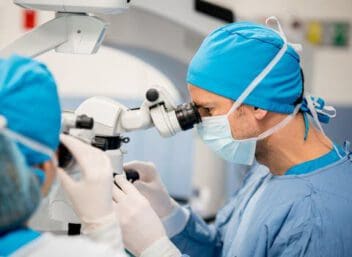Overview & Tips for the TMOD Exam
Home / Vision Education Center / Optometrist Salary /
Last Updated:
The TMOD exam is part of the National Board of Examiners in Optometry exam, which reviews every part of optometric practice. It is broken up into four parts, with optional components, starting with Applied Basic Science.
The TMOD exam itself is part of the Patient Assessment and Management exam, but some states might require a separate TMOD test. Some states require all four parts of the NBEO exam, while others need only the first two.
Table of Contents
What Is the TMOD Exam?

The TMOD exam is a series of tests that optometry students must pass in order to become a professional optometrist. TMOD stands for Treatment and Management of Ocular Diseases, and it is overseen by the National Board of Examiners in Optometry (NBEO).
There are three parts to the exam:
You deserve clear vision. We can help.
With 135+ locations and over 2.5 million procedures performed, our board-certified eye surgeons deliver results you can trust. Your journey to better vision starts here.
- Applied Basic Science (Part I)
- Patient Assessment and Management (Part II)
- Clinical Skills (III)
An optional component is the Advanced Competency in Medical Optometry exam.
Applied Basic Science (Part I)
The Applied Basic Science part of the TMOD exam has 500 questions on diagnosis, clinical testing, pathophysiology, symptoms, patient history, and epidemiology. The exam is conducted over 3.5 hours, broken up into four sessions. Each session has 125 questions.
This first part of the TMOD is given to optometry students in their third academic year.
Patient Assessment & Management (Part II)

The second part of the exam, Patient Assessment and Management, is a written exam that asks questions on 30 scenarios centered around patient care. Part II is administered across two sessions, each one 3.5 hours.
Students are given a patient history and clinical data, and then have to answer multiple choice questions about their case. The questions can cover everything from fundamental scientific principles, ethics, law, and public health to the actual treatment and management of ocular diseases.
Students will have to consider diagnosis, assessment, and/or treatment in their answers. The hypothetical scenarios will focus on disease or trauma, or functional or refractive conditions.
Part II & the TMOD Exam
The National Board of Examiners in Optometry used to offer a separate TMOD exam, but because the Patient Assessment and Management section of the exam covers ocular disease and trauma, the standalone TMOD exam was discontinued in 2009.
While most states will accept the TMOD score in Part II of the exam, some states still require that candidates take a separate TMOD exam. Students who do not intend to practice optometry in those states can still request to take a separate TMOD exam. For students who want to practice in those states, the standalone TMOD exam is not optional.
The Patient Assessment and Management part of the TMOD exam is given to students in their last year at optometry school.
You deserve clear vision. We can help.
With 135+ locations and over 2.5 million procedures performed, our board-certified eye surgeons deliver results you can trust. Your journey to better vision starts here.
Clinical Skills (Part III)

The Clinical Skills part of the exam has four sections. Candidates will examine four patients for 30 minutes each, at four different stations. They will then be evaluated on how they met the criteria for 19 clinical skills.
At the first station, the skills are case history and patient communication; a near cover test; binocular extraocular muscle motility evaluation; blood pressure measurement; and ophthalmic lens evaluation.
At the second station, the skills are pupil testing; biomicroscopy; Goldmann applanation tonometry (to measure intraocular pressure); gonioscopy; collagen implant insertion and removal; and patient education in ocular disease management.
At the third station, the skills are retinoscopy; distance subjective refraction; heterophoria and distance vergence testing; and accommodation testing.
At the fourth station, the skills are binocular indirect ophthalmoscopy; dilated biomicroscopy and non-contact fundus lens evaluation; insertion, evaluation and removal of soft contact lenses; and insertion, evaluation, and removal of gas permeable contact lenses.
Part III exams are available to students in the final year of optometry school. While the other parts of the TMOD exam can be attempted a certain number of times, the Clinical Skills portion of the exam can be attempted only once.
Advanced Competency in Medical Optometry
The Advanced Competency in Medical Optometry (ACMO) exam is meant for doctors of optometry who have finished a residency program in the Veterans Affairs system. The ACMO is an optional exam. An optometrist who passes it receives similar professional acknowledgement and recognition that other practitioners within the VA system have.
The Advanced Competency in Medical Optometry exam has 160 cases, connected to 40 individual patient cases. Each patient case is followed by four sections: questions on diagnosis, questions on diagnostic follow-up, questions on treatment, and questions on treatment follow-up.
To take the ACMO exam, you must either have:
- Completed an accredited VA residency program
- Completed an accredited residency program, and been involved in the training and education of optometry residents at the VA
- Or given optometric care to VA residents
The Advanced Competency in Medical Optometry exam is offered only once a year, every June, and lasts 4.5 hours.
By State & Territory
The NBEO exam Parts I, II, and III are required by Alabama, California, Michigan, Nevada, Oklahoma, Puerto Rico, and Wisconsin.
The NBEO Parts I and II, and the separate TMOD exam, are required by Florida and North Carolina.
The NBEO Parts I and II are sufficient in Louisiana and the Virgin Islands.
The District of Columbia and the remaining 41 states require all four exams: the NBEO Parts I, II, and III, and the TMOD.
Some states (such as California, Georgia, Texas, and Nebraska, among others) also administer a test on their respective state laws. Many other states don’t.
Every jurisdiction requires a combination of written and practical tests, tests on pharmacology, oral exams, and interviews. Optometry students should doublecheck licensure requirements with their state boards before attempting any tests.
Registration & Scoring
The NBEO allows for online registration and online payment for each of the different parts of the exam. Parts I, II, and III cost $625 apiece. The TMOD standalone exam is $450, and the ACMO exam is $780. The individual state law exams are $70.
Parts I, II, and III of the NBEO exam are scored from 100 to 900 points. The pass-fail threshold is 300 points. The other sections (TMOD and ACMO) are scored from 0 to 99 points, with the pass-fail cutoff at 75.
You deserve clear vision. We can help.
With 135+ locations and over 2.5 million procedures performed, our board-certified eye surgeons deliver results you can trust. Your journey to better vision starts here.
References
- Everything You Need to Know About NBEO® Part II. (November 2019). OptoPrep.
- Summary of the Optometry National Board Exam (NBEO). (December 2010.) OptometryStudents.com.
- Examination Innovation: Transforming the National Board of Examiners in Optometry’s Clinical Skills Examination. (December 2019). Optometry and Vision Science.
This content is for informational purposes only. It may have been reviewed by a licensed physician, but is not intended to serve as a substitute for professional medical advice. Always consult your healthcare provider with any health concerns. For more, read our Privacy Policy and Editorial Policy.